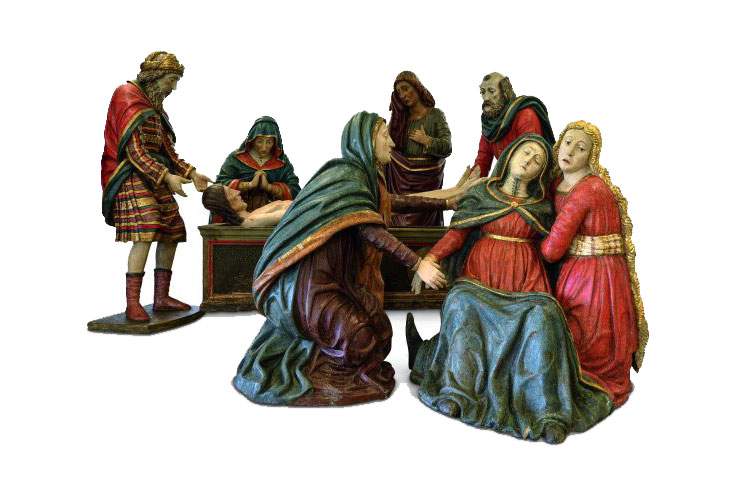Milan ’s Castello Sforzesco returns to Renaissance sculpture after the major exhibition Il Corpo e l’Anima, da Donatello a Michelangelo. Italian Renaissance Sculpture, the major exhibition that occupied the Sale Viscontee from July 21 to October 24, 2021. From Oct. 21, 2021 to Jan. 16, 2022, in fact, Castello Sforzesco is organizing, in the Sala della Balla, the exhibition Wooden Sculptures in Comparison from the Ducal Cities of Vigevano and Milan, curated by Claudio Salsi, Area Director Superintendence Castle, Archaeological Museums and Historical Museums of the City of Milan. Promoted and organized by Castello Sforzesco - Municipality of Milan - Culture with Soprintendenza Archeologia Belle Arti e Paesaggio for the Provinces of Como Lecco Monza-Brianza Pavia Sondrio and Varese, City of Vigevano and Diocese of Vigevano, the exhibition is co-produced with Civita Mostre e Musei and supported by Fondazione Cariplo.
Conceived as a natural continuation of the exhibition Il Corpo e l’Anima (The Body and the Soul), this initiative constitutes a further in-depth study around polychrome wooden sculptures from the Lombard area, proposing a double focus on the Lamentation of St. Dionysius and the Ancona of St. Joseph from Vigevano, as Milan was the seat of an ’important Sforza court between the fifteenth and sixteenth centuries. The one examined by the exhibition is a period of flourishing artistic production in the Lombard territory between the time of Ludovico il Moro, the French domination and the time of the last Duke Francesco II Sforza, who in the early 1630s devoted himself to the redevelopment of the castle and cathedral of Vigevano. A time when many courts, now rivals, now allies, all splendid and often related by convenient marriages, despite the succession of political and military turmoil and pestilence, helped to give birth in Italy to that golden age of art that would produce not only masterpieces already universally known, but also works of liturgical destination of extraordinary workmanship and aesthetic quality still largely to be discovered, as the present exhibition sets out to demonstrate.
The sculptures have recently undergone restoration, scientific and documentary investigations, carried out in synergy between the competent territorial Superintendency and the Milan Castle. The Ministry’s protective action is combined with the Milanese museum’s function of enhancement; this collaboration allows the works to be exhibited decontextualized from their original environment, but clearly visible and presented in a way that makes their stylistic values and refined details legible. This allows a series of comparisons with some works from the Castello Sforzesco, such as the figures from the lost Lamentation from the Milanese church of Santa Maria Bianca in Casoretto, juxtaposed for the occasion with the Vigevano sculptures.
The placement within the museum itinerary of Milan’s Castello Sforzesco also fosters a dialogue with the permanent collection on display at the Museo dei Mobili e delle Sculture Lignee (Corte Ducale), one of the largest collections of Lombard Renaissance sculpture, and with the Tapestries of the Mesi Trivulzio on display in the Sala della Balla, woven in Vigevano in the early sixteenth century to a design by Bartolomeo Suardi known as Bramantino, on the same dates as the sculptures on display here today were carved and painted. The layout, curated by architect Andrea Perin, is intended to encourage an analytical approach, with the possibility of contemplating the wooden groups from every angle, so as to admire both their technical and constructive peculiarities and to appreciate the arrangement of the individual figures. A richly illustrated catalog, edited by Claudio Salsi and published by Marsilio Editori, accompanies the exhibition as a subsidy for the study of the Vigevano heritage, thanks also to a large section of documents, the result of accurate surveys among archives carried out for the occasion.
The exhibition opens Tuesday through Sunday from 10 a.m. to 5:30 p.m., last admission 5 p.m. (ticket office closes at 4:30 p.m.). The ticket is unique for the Castle museums and exhibitions: Until October 24, 2021 : € 10.00 full € 8.00 reduced 18-25 years and over 65; from October 26, 2021 to January 16, 2022: € 7.00 full € 5.00 reduced 18-25 years and over 65. Free under 18, Free every first and third Tuesday of the month from 2 p.m. For more information see the Castello Sforzesco website.
Pictured is the Lamentation of Vigevano.
 |
| Milan, an exhibition on Renaissance wooden sculpture at Sforza Castle |
Warning: the translation into English of the original Italian article was created using automatic tools. We undertake to review all articles, but we do not guarantee the total absence of inaccuracies in the translation due to the program. You can find the original by clicking on the ITA button. If you find any mistake,please contact us.